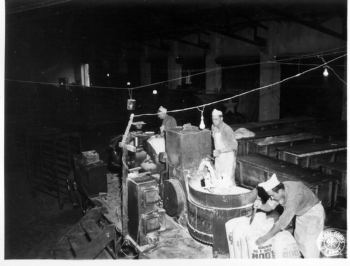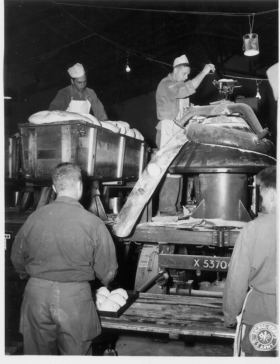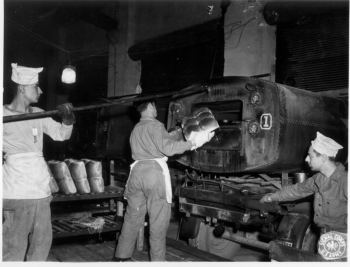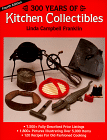
3032nd Bakery Company in Toul, France
Photographs by the 166th Signal Photo Company
U.S. Army Quartermaster bakery companies in the European Theater of Operations used the equipment shown in these photographs from the summer of 1943 to the end of the war. In January 1943, the Bakery Section of the Office of the Chief Quartermaster for ETO, led by Maj. John "Jack" MacManus, adopted British-designed mobile field bakery equipment in place of the inferior U.S.-manufactured M1942 field bake oven.
The table of organization and equipment for the mobile bakery company called for three major pieces of equipment:
One trailer-mounted dough mixer, divider and rounder.
Three trailer-mounted diesel ovens.
Two diesel generators.
Unlike companies that used the M1942 field oven, the mobile bakery company was one hundred percent mobile. It could move forward with the army without any assistance from motor transportation companies. Bakery companies equipped with the M1942 oven, which consisted of 32 ovens and 16 gasoline-powered mixers, required 40 2-1/2 ton trucks every time they needed to move. Both companies produced 24,000 to 25,000 pounds of bread per day.
Diesel-Electric Dough Mixer
 These bakers, working out of a warehouse in
Toul, France, are preparing bread for the Army. The first
baker (right) is cutting open flour sacks with a
cook's knife in preparation for the next dough. After the
dough is mixed, he will transfer it into one of the dough
troughs seen to the right for fermentation. The second
baker (center) operates the divider, which cuts
the dough into loaf-sized pieces. The third baker (left)
operates the rounder.
These bakers, working out of a warehouse in
Toul, France, are preparing bread for the Army. The first
baker (right) is cutting open flour sacks with a
cook's knife in preparation for the next dough. After the
dough is mixed, he will transfer it into one of the dough
troughs seen to the right for fermentation. The second
baker (center) operates the divider, which cuts
the dough into loaf-sized pieces. The third baker (left)
operates the rounder.
Diesel-Electric Divider and Rounder
 Four bakers prepare loaves
of bread for baking using British-designed baking
equipment. The first baker (upper left) is the
soldier who is operating the divider in the upper
photograph. He is cutting large portions of dough that
will be fed into the divider. After the dough was fed
through the divider, it moves to the rounder on a
conveyor. The rounder operator (upper right)
appears to be checking each the weight of each piece of
dough with a baker's scale. The baker standing (lower
left) at the base of the rounder shoot pans six
loaves into a standard Army bake and roasting pan
(3" by 12" by 24"). The fourth baker (lower
right) takes each pan and places it onto proofing
racks.
Four bakers prepare loaves
of bread for baking using British-designed baking
equipment. The first baker (upper left) is the
soldier who is operating the divider in the upper
photograph. He is cutting large portions of dough that
will be fed into the divider. After the dough was fed
through the divider, it moves to the rounder on a
conveyor. The rounder operator (upper right)
appears to be checking each the weight of each piece of
dough with a baker's scale. The baker standing (lower
left) at the base of the rounder shoot pans six
loaves into a standard Army bake and roasting pan
(3" by 12" by 24"). The fourth baker (lower
right) takes each pan and places it onto proofing
racks.
Diesel Oven
 It took two
bakers to operate the oven. The first baker (left)
pulled each pan of bread to the oven door with the long
hook. As each pan is pulled to the door, the second baker
(center) catches the pan and dumps it onto the
bread-carrying rack. The third baker (right)
appears to only be observing the operation.
It took two
bakers to operate the oven. The first baker (left)
pulled each pan of bread to the oven door with the long
hook. As each pan is pulled to the door, the second baker
(center) catches the pan and dumps it onto the
bread-carrying rack. The third baker (right)
appears to only be observing the operation.
Mobile Bakery Companies in the ETO
According to The Quartermaster Corps: Operations in the War Against Germany, each bakery company was reorganized into two mobile bakery companies and equipped with British equipment after it arrived in England. By D-Day, 42 companies were available for assignment on the European continent. By the time hostilities ended in April 1945, 55 companies had been trained in Boughton Park, the Army's Quartermaster bakery training center near Kettering.
The 3028th and 3029th Bakery Companies spearheaded bakery operations on the far shore. These companies landed at Utah Beach on July 1 and June 30, 1944, respectively. Together, they were producing 60,000 pounds of bread each day for the 1st U.S. Army. By July 20, 20 companies had landed.
Thirty-eight companies were ashore and operating in the field one month before the Battle of the Bulge. On VE Day, 29 of the 55 mobile bakery companies on the continent were assigned to the field armies. The remainder were distributed throughout the rear area.
Bibliography
Ross,William F. and Charles F. Romanus. The Quartermaster Corps: Operations in the War Against Germany. A volume of United States Army in World War II: The Technical Services. (Washington: GPO), 798pp. Pages 515-20 explain baking operations.
September 1999
| Bulletin Board | Keyword Search |
| Bookstore | Links |
| About Us | Recent Additions |

